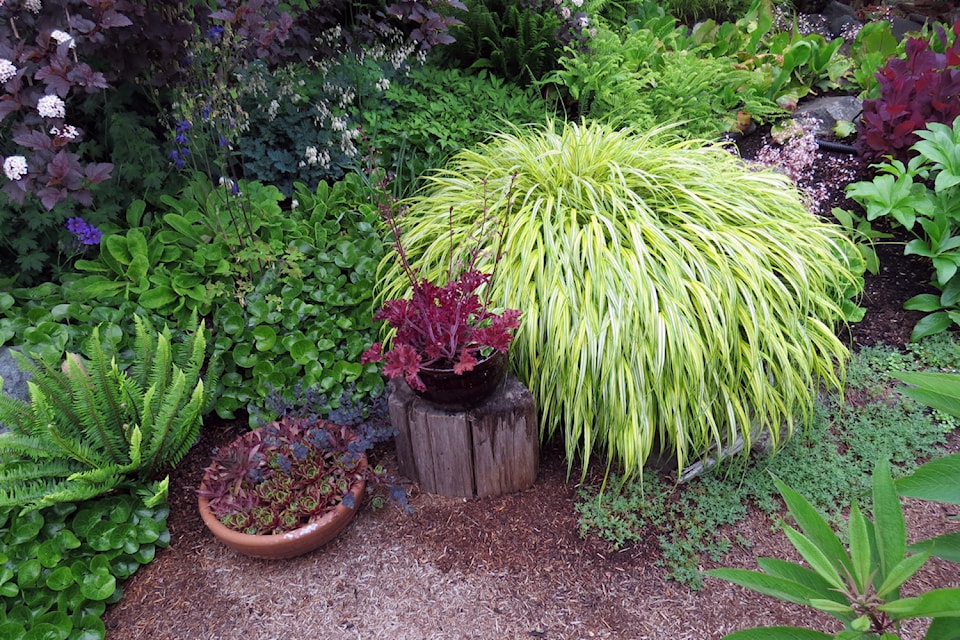Drought tolerance is certainly a virtue in our gardens as the average temperature on our planet keeps rising.
Thank goodness there are a few lovely plant specimens available which are great show pieces, in spite of the heat and humidity. The following are just a few which have performed well in our garden.
Thalictrum flavum ssp. glaucum (yellow meadow rue) is one which really impresses me. Standing four feet (1.2 m) tall, you would think this plant would languish like a wet noodle in the heat of the day, especially since it resides in a sunny location at the edge of an island bed where the garden path splits left and right. Nope! And no scorch marks on its leaves from heat stress either. Add more bonus points for all the bees its flowers attract as well.
It is hard not to fall in love with the vast array of hardy geranium specimens - better known as cranesbill. And there are dozens and dozens to choose from ranging in height from small ground huggers to a few whose flowers will brush your waistline as you walk by; they hare a good selection of flower colours too, with the exception of yellow, orange and red. But hey, who needs those shades when you can get masses of vibrant magenta flowers decorated with a stunning purple-black eye that last pretty much the whole summer?
Admittedly, flowering will be a tad better if you can grant Geranium psilostemon (pronounced sil-oh-stem-on) a little afternoon shade, but they are not seriously impacted by less than regular watering.
Indeed, this plant genus is pretty much bullet-tough. In the immortal words of native Victoria garden guru and hardy geranium fan, Phoebe Noble, “Just run over them with a lawn mower when they finish flowering for a fresh flush of leaves.” That says it all, indeed.
And who can argue the virtues of grasses in the garden? Another plant group with a good range of both size and pleasing form variation. You certainly cannot miss our Miscanthus sinensis ‘Cosmopolitan’ in the back garden; it kind of stands out when it reaches its full eight feet (2.4 m) height in mid-summer - especially with its variegated leaf blades of creamy-white and bright green.
We have acquired quite a range of grass genus and species in our garden: Miscanthus (maiden grass), Carex (sedge), Chasmanthium (northern sea oats), Molinia (millet), Panicum (switch grass), Hakonechloa (forest grass), and probably a couple more that I have missed.
Of all these grasses only some of the Carex species have proven to be a little disappointing for the splotches of scorch marks that develop on their dense mound of leaf blades. In particular, I have found the Japanese sedges, Carex morrowii ‘Ice Dance’ and C. m. ‘Silver Sceptre’ to be susceptible. Since the experts strongly recommend not cutting Japanese sedges back to four inches (10 cm) or so, I will sometimes take the time and cut away the most offending blades.
Of course, there is always the possibility that I do not water these two grasses enough for their liking. So, if or when I get tired of this white, green and brown variegation on ‘Ice Dance’ and ‘Silver Sceptre’ I will likely do away with them. Small chance the temperature will be cooling down to their comfort level.
As for heat resistant plant surprises, I mentioned maidenhair fern in my last column that is largely thriving in almost full sun. Add shade-loving Brunnera (Siberian bugloss) and wild European ginger whose volunteer seedlings are now growing…and thriving…in full sun. Go figure!
Come see these plants in our garden now open Wednesdays to Sundays from 10 a.m. to 5 p.m.
Need directions to our garden? Contact me through my website: duchessofdirt.ca.

